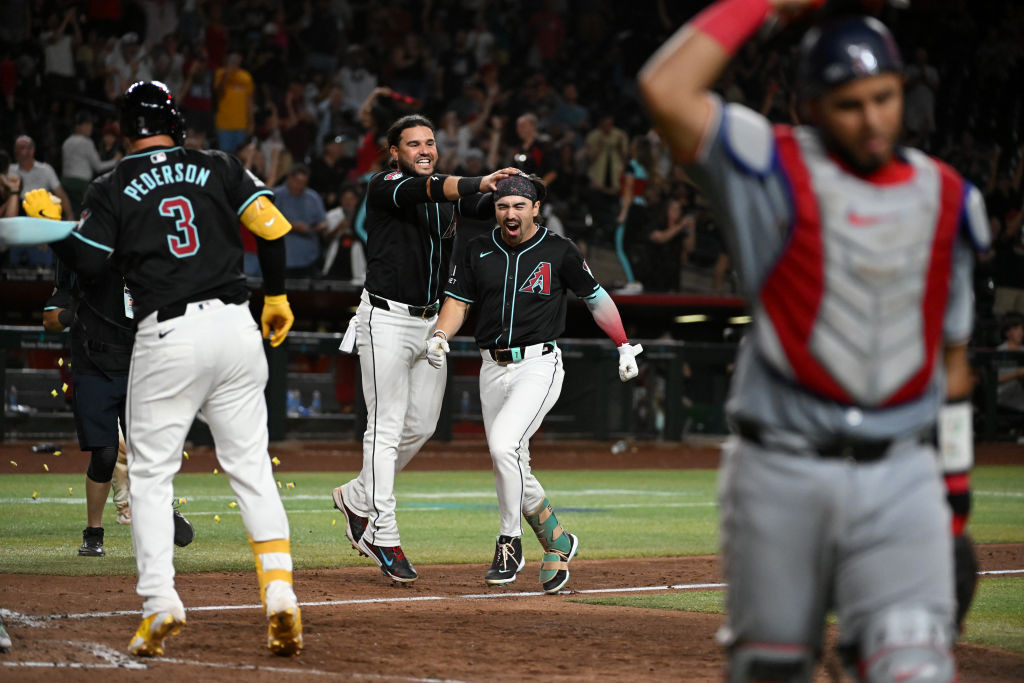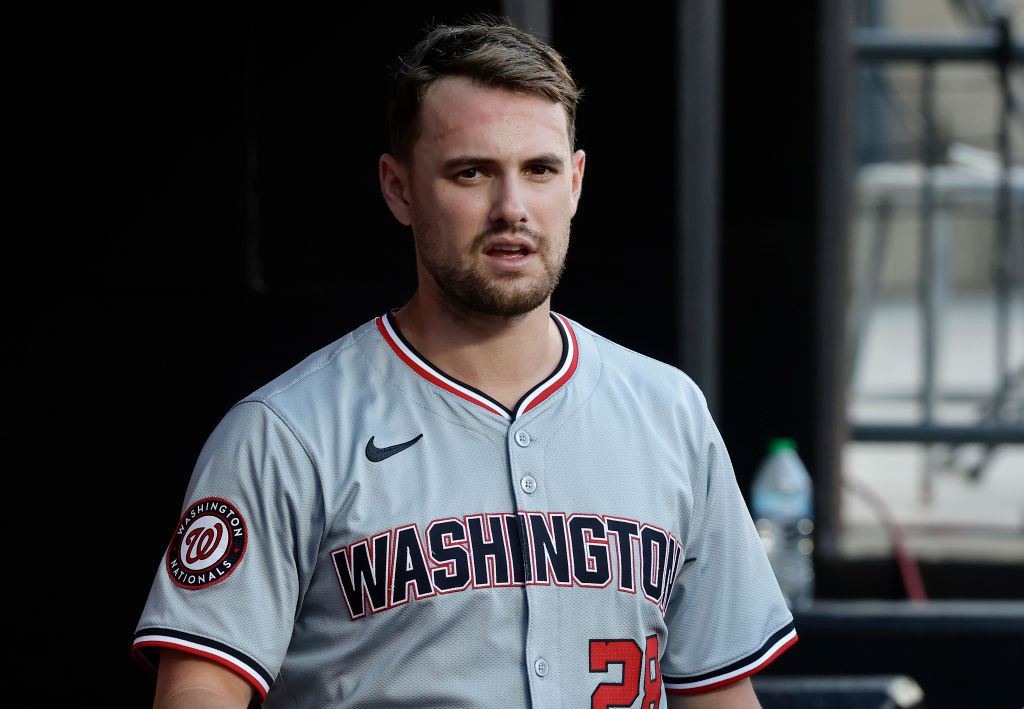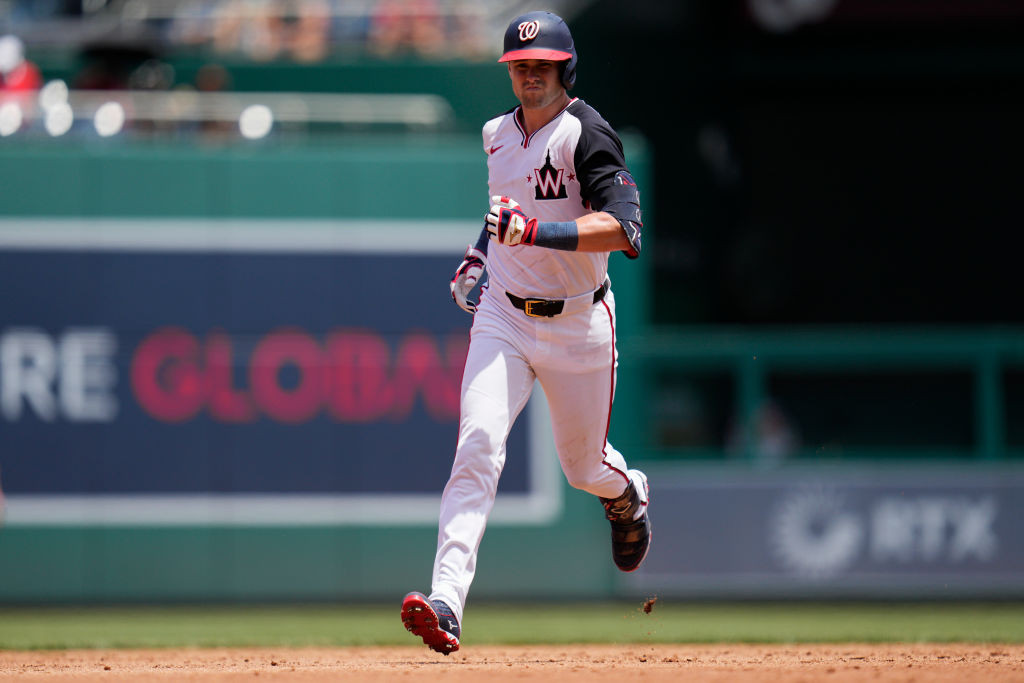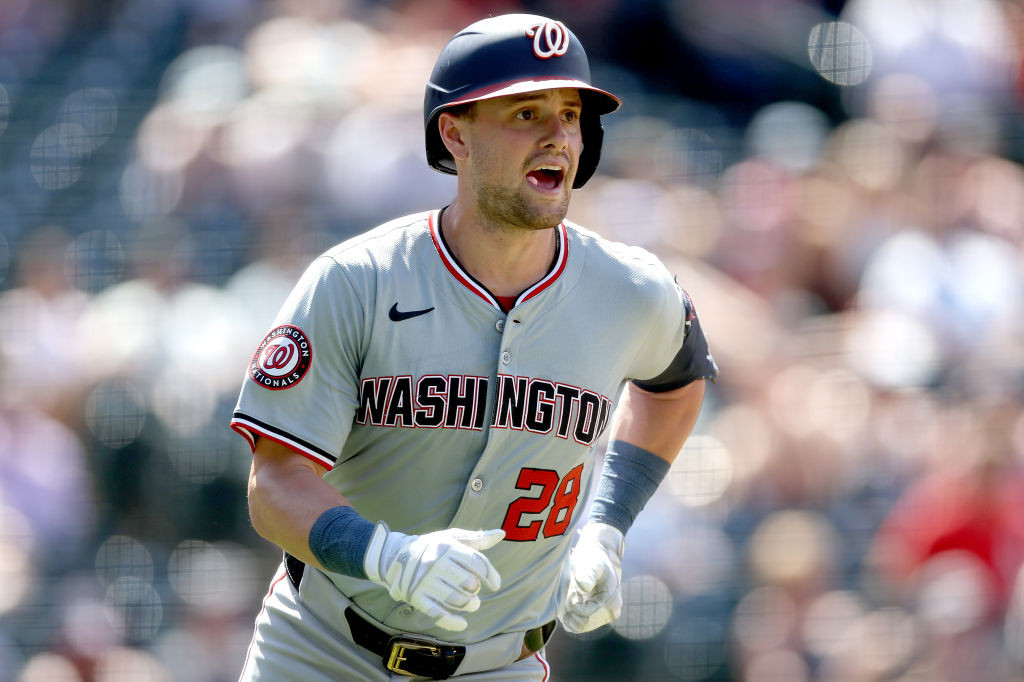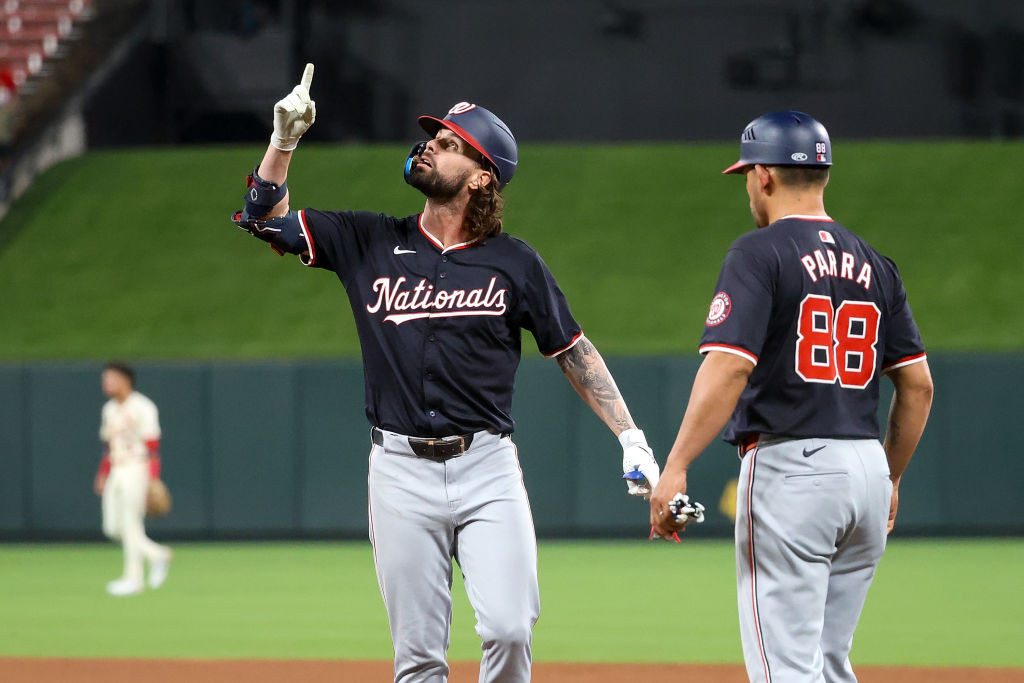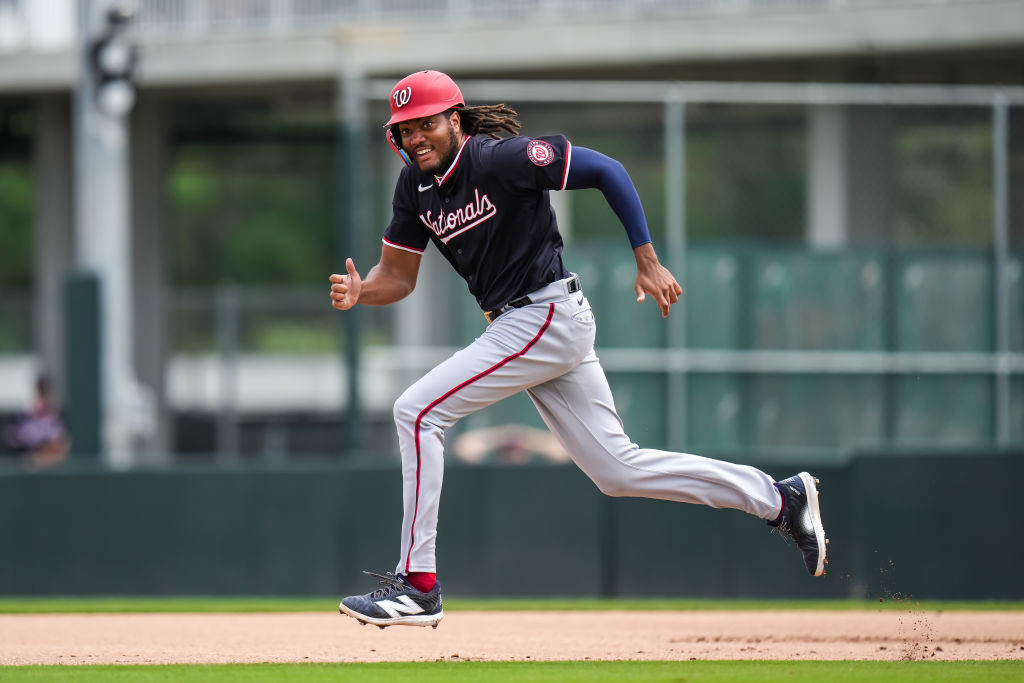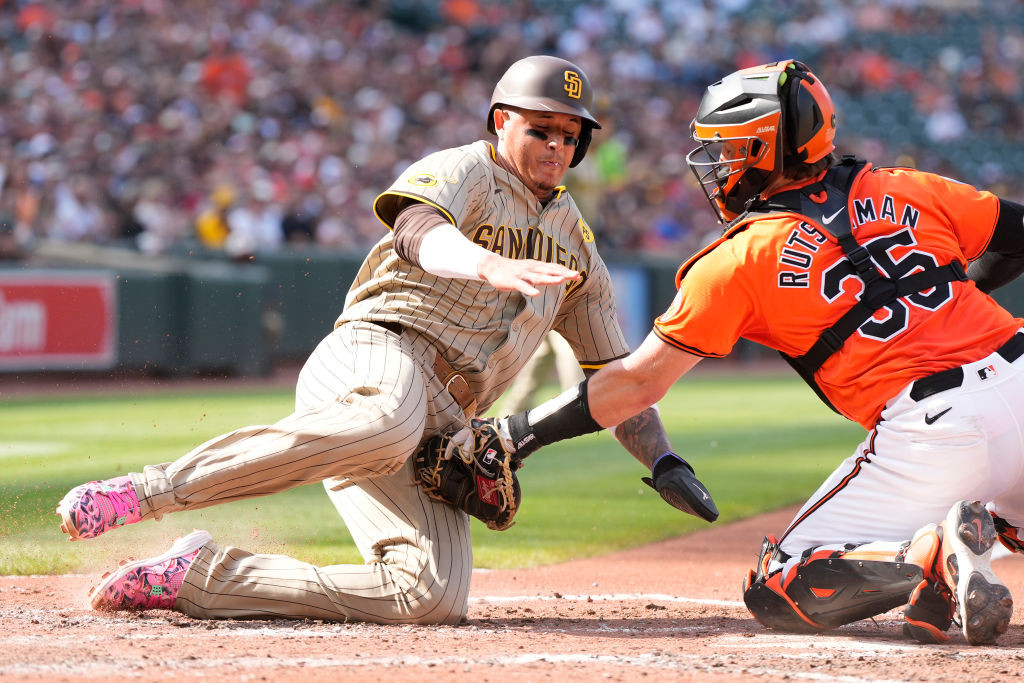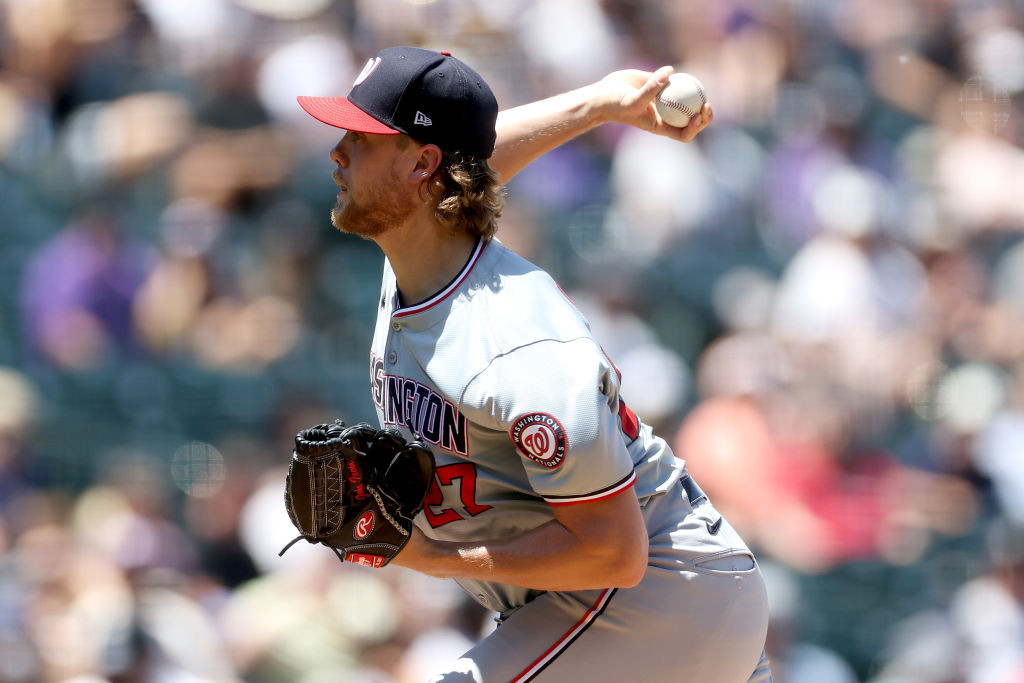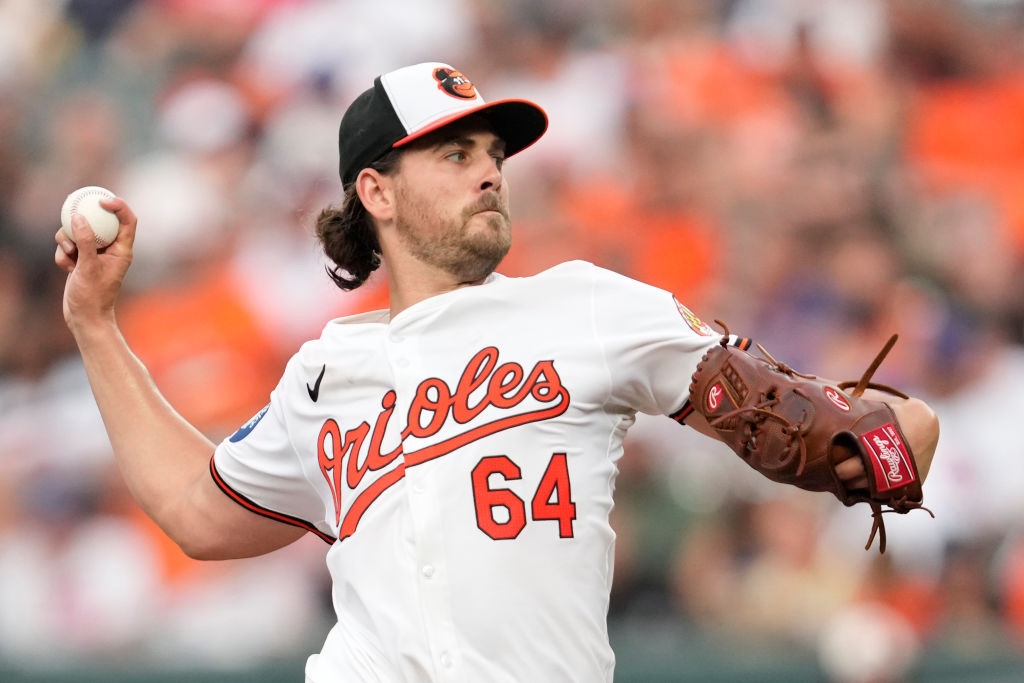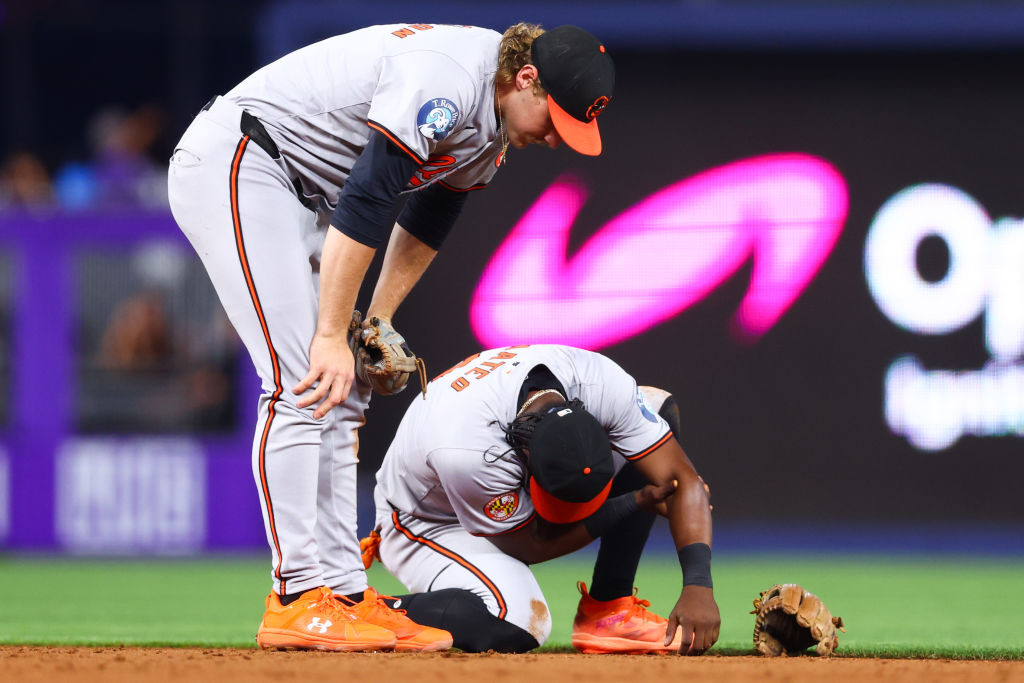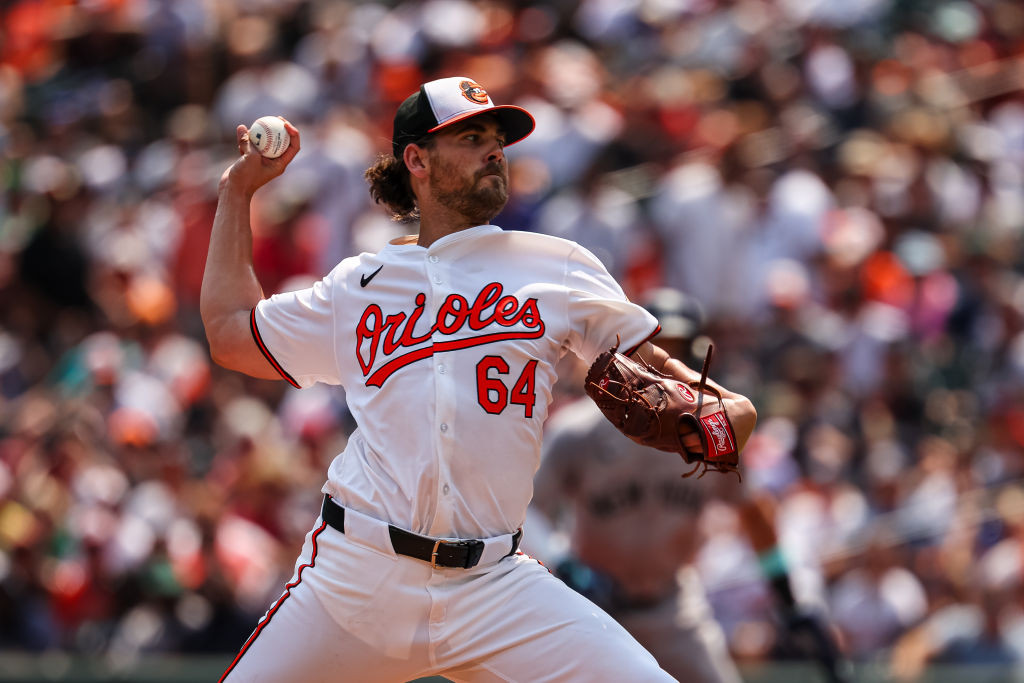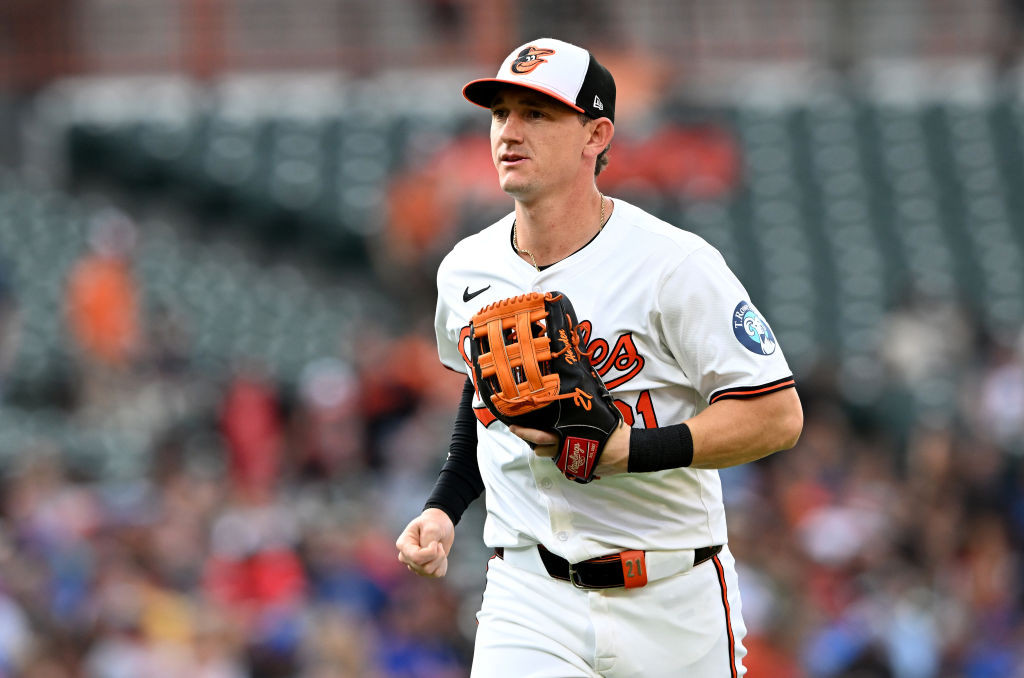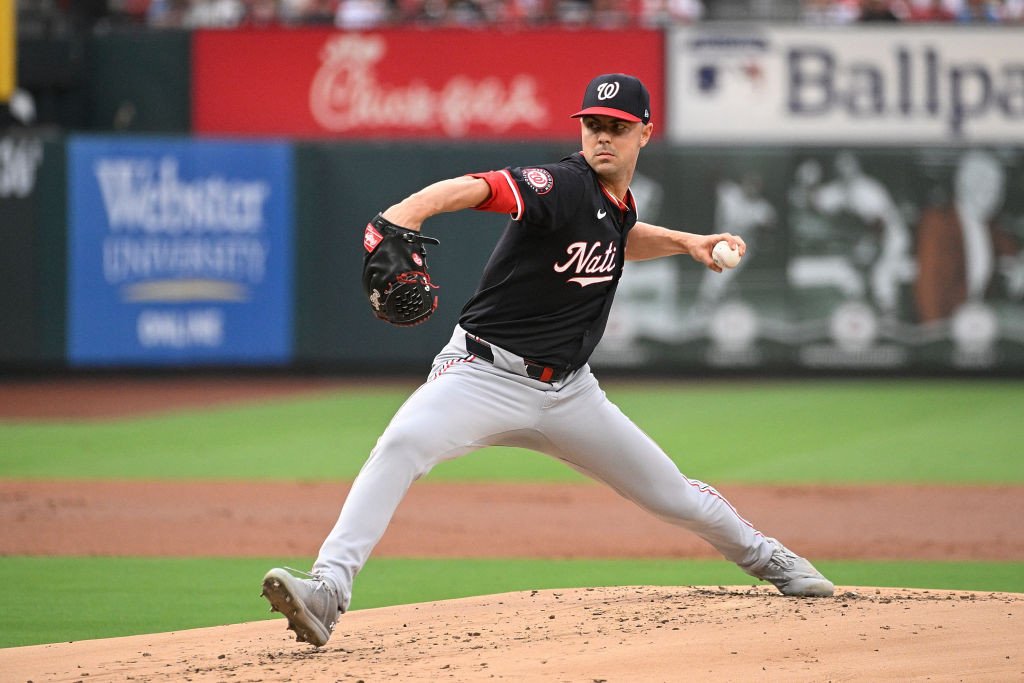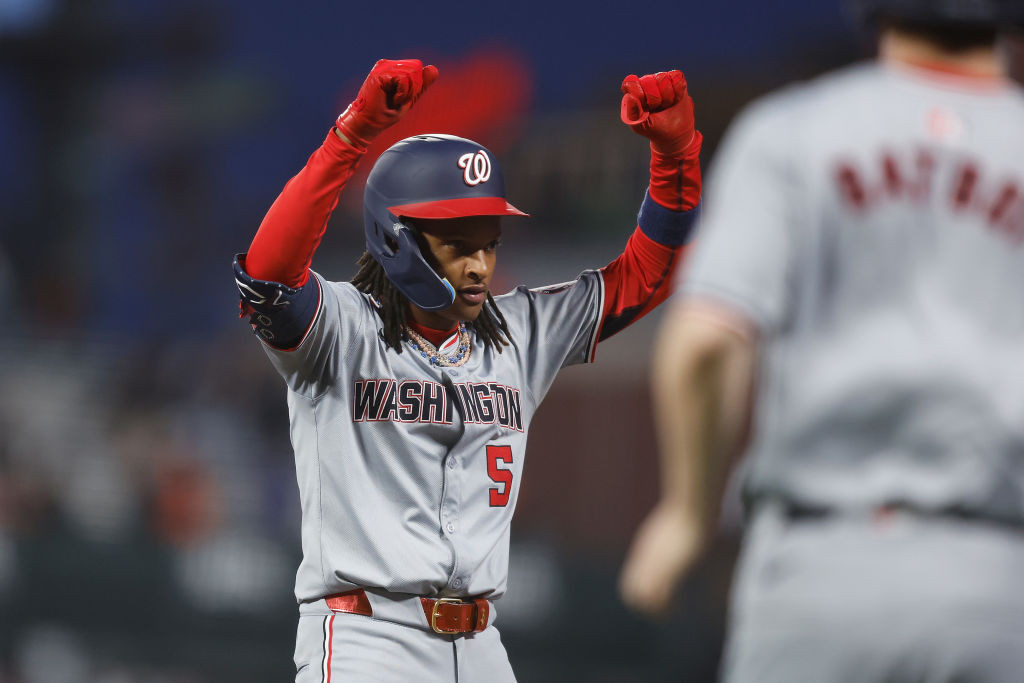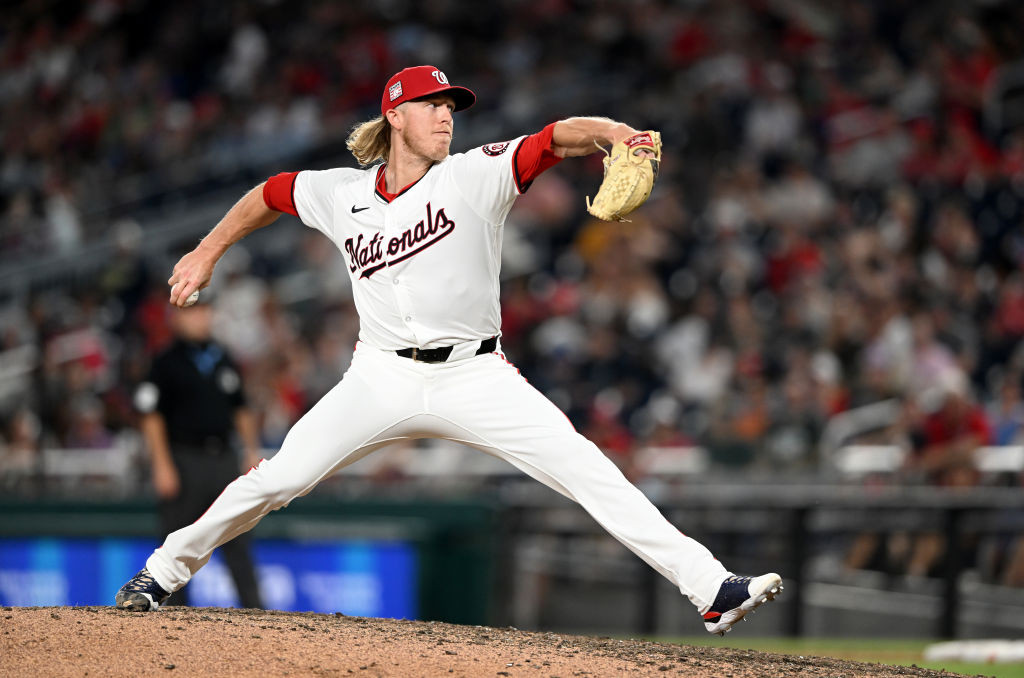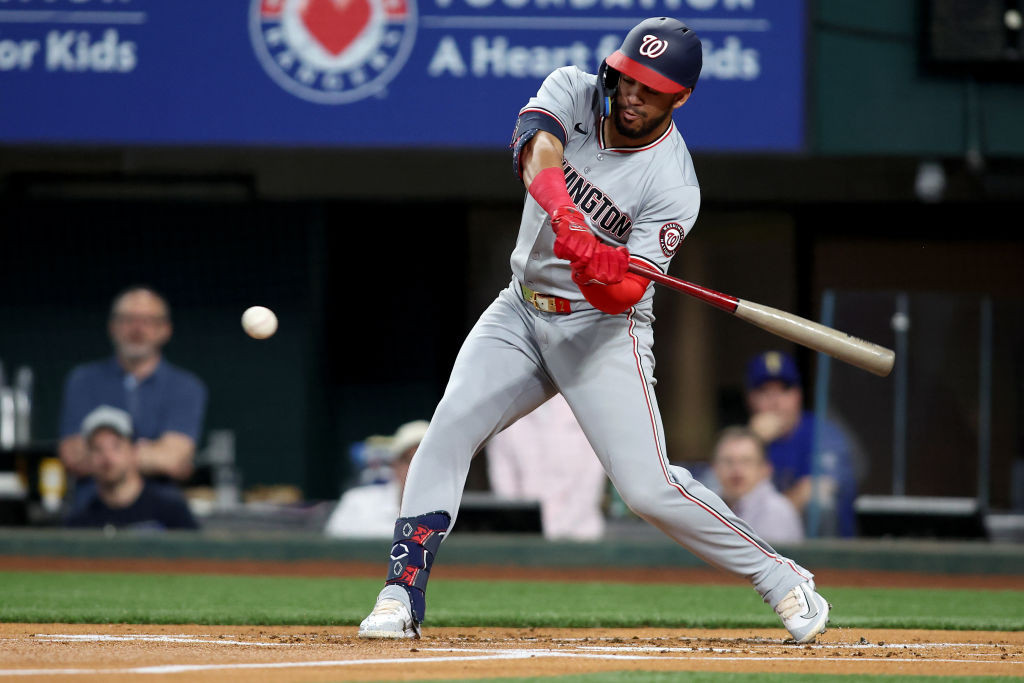PHOENIX – The news was only minutes old, and Davey Martinez was still trying to process it and express his thanks to Lane Thomas while also trying to figure out what to do with his lineup for a game that was set to begin in less than three hours.
"It's tough, but I've still got 25 guys out there to get ready to play Arizona," the Nationals manager said shortly after 4 p.m. "They've been playing really well. We've got to be upbeat. It's part of the game. I can only control what I can control, and that's to get these guys ready to play."
The Nats were ready to play tonight, no doubt. They stormed out of the gates to score five runs in the top of the first, then opened up a six-run lead in the top of the sixth and carried a four-run lead into the bottom of the ninth. At which point disaster struck.
Kyle Finnegan, the subject of plenty of trade rumors himself, blew that four-run lead in the ninth and took a shocking 9-8 loss. The All-Star closer retired only one of the six batters he faced, giving up homers to Ketel Marte and ultimately a walk-off homer to Corbin Carroll that left Chase Field shaking and the visitors slumping their way back to the dugout.
"In this game, no lead is ever safe, no team is ever out of it," Finnegan said. "You've got three outs to get to win the game, and they're not going to concede the game. They're not going to give away at-bats. They're trying to win the game. And I think they just took really quality at-bats, and I wasn't able to make good enough pitches to get them out."
The Orioles have made the following roster move:
- Returned 27th man LHP Cade Povich to Triple-A Norfolk after today’s doubleheader.
PHOENIX – Lane Thomas joined the Nationals on the day the organization began to tear down its championship roster and start a massive roster rebuild. Three years later, with the franchise believing its much closer to winning again, he’s heading to another organization right in the thick of a pennant race.
The Nats traded Thomas to the Guardians this afternoon for three prospects, including highly touted 19-year-old left-hander Alex Clemmey, opting to deal one of their coveted regulars who still had another season of club control about 24 hours before Tuesday’s trade deadline.
Along with Clemmey, Cleveland’s 2023 second-round pick and current No. 7 prospect, the Nationals receive 19-year-old infielder Rafael Ramirez Jr. and 23-year-old infielder Jose Tena, who has big league experience and joins the 40-man roster.
It’s a significant haul for the 28-year-old Thomas, who got off to a slow start this season but entered the day batting .253 with eight homers, 40 RBIs, 28 stolen bases and a .738 OPS in 77 games. The outfielder spent the last few days trying to block out trade rumors but wasn’t caught completely off-guard when he was called into manager Davey Martinez’s office at Chase Field about three hours before tonight’s series opener against the Diamondbacks.
“It’s always a little bit of a shock, even when you know they’re looking to do something like that,” Thomas said. “I’ve been in this situation before, so I feel like that makes it a little bit easier. My wife has dealt with it, too. I think we’re ready to go help another team.”
The Washington Nationals acquired left-handed pitcher Alex Clemmey, infielder José Tena and infielder Rafael Ramirez Jr. from the Cleveland Guardians in exchange for outfielder Lane Thomas on Monday. Nationals President of Baseball Operations and General Manager Mike Rizzo made the announcement.
Clemmey, is Cleveland’s No. 7 prospect according to Baseball America and its No. 8 prospect according to MLBPipeline.com In his first professional season, Clemmey has struck out 97 batters with a .214 opponents’ batting average in 69.1 innings pitched for Single-A Lynchburg. His 97 strikeouts rank third in the Carolina League and fifth among Guardians farmhands. On the season, he is 1-4 with a 4.67 ERA in 19 starts. Baseball America also cites Clemmey as having the “Best Curveball” among Cleveland Minor Leaguers.
The 6-foot-6, 205-pound Clemmey has pitched to a 2.28 ERA (11 ER/43.1 IP) with 63 strikeouts, a 1.18 WHIP, a .185 opponents’ average and just two home runs allowed in his last 11 starts since May 24. During this stretch, he tossed 4.2 shutout innings with eight strikeouts and three hits on June 12 vs. Augusta (ATL) and on July 5 vs. Salem (BOS), he struck out seven batters in 4.0 no-hit innings. He kicked off the strong run with 5.0 innings of one-hit, shutout ball on May 24 at Fredericksburg (WSH).
The 19-year-old was Cleveland’s second-round pick (No. 58 overall) in the 2023 First-Year Player Draft out of Bishop Hendricken (RI) High School. He was named Rhode Island's 2023 Gatorade Player of the Year after finishing his senior year with a 9-1 record and 0.42 ERA (2 ER/43.0 IP) with 105 strikeouts in 10 starts. Clemmey was ranked by Baseball America as the No. 49 prospect in the 2023 First-Year Player Draft and the No. 3 high school left-handed pitcher in the draft, according to Perfect Game.
Tena, 23, leads Cleveland’s Minor League system with 110 hits and ranks in home runs (2nd, 17), RBI (3rd, 63), extra-base hits (4th, 36), batting average (4th, .298), slugging percentage (6th, .493) and OPS (6th, .846). He’s clubbed 17 doubles and recorded 14 stolen bases in 90 games for Triple-A Columbus this season. Tena is a career .286/.339/.443 hitter with 109 doubles, 22 triples, 57 home runs, 152 walks, 64 stolen bases and 304 runs scored in 520 games across five Minor League seasons.
ST. LOUIS – Anyone who has followed the Nationals since 2021 understands the stress that accompanies the trade deadline for a team more interested in dealing major leaguers than acquiring them.
Nothing will ever top the stress of July 2021, when Max Scherzer, Trea Turner and six other veterans were shipped off in less than 36 hours, kickstarting the franchise’s rebuild. Nor the stress of July 2022, when a generational player named Juan Soto went from untouchable to traded in the span of two weeks.
This year’s trade deadline period won’t match those, but it does bring with it an entirely different type of stress. This isn’t about trading away big name stars for a horde of prospects who won’t reach the majors for years. This is about the philosophy of a Nationals organization at an important crossroads in this rebuild project.
Do the Nats believe they’re ready to win in 2025? If so, do they believe their two most valuable trade chips right now – closer Kyle Finnegan, right fielder Lane Thomas – should be a part of a 2025 roster built to contend? Or do they believe success still lies further down the road, or that they can still be in a position to win next year even if they deal Finnegan and Thomas?
“I think we’re going in the right direction,” general manager Mike Rizzo said last week. “I think we’re on time and doing the right things. I think that when you look at where we were when we started this thing in 2021, I think it’s palatable. I think you could feel it. I think you could see that there’s a light at the end of the tunnel.”
ST. LOUIS – When Davey Martinez sent Harold Ramírez to the plate to pinch-hit for Jesse Winker in the top of the sixth tonight, it made perfect baseball sense. The Nationals, who had squandered bases-loaded opportunities each of the previous two innings, had yet another opportunity with the bags full in a tight ballgame. And with Cardinals manager Oli Marmol summoning left-hander Matthew Liberatore from the bullpen, of course Martinez would have the right-handed Ramírez bat for the left-handed Winker.
Ramírez proceeded to deliver the clutch hit the Nats had been seeking all night, sparking a seven-run rally that turned a tight ballgame at Busch Stadium into an eventual 14-3 rout. But it turns out the pinch-hit move by Martinez, though purely strategic in the moment, carried far more significance than anyone realized at the time.
Winker, who turned a minor league contract and a spring training invitation into a .793 OPS and a regular spot batting third for the Nats, was traded to the Mets for pitching prospect Tyler Stuart, the club officially announced Sunday morning.
Winker, who is due to become a free agent at season’s end and looked like the team's most logical candidate to be dealt prior to Tuesday’s major league deadline, wound up getting dealt in-game to a division rival for Stuart, a 24-year-old right-hander who was rated New York's No. 17 prospect by MLB Pipeline. The 6-foot-9 starter had a 3.96 ERA, 1.250 WHIP and 90 strikeouts with only 20 walks in 84 innings this season at Double-A Binghamton. He led all qualified full-season starters across the minor leagues last season with a 2.20 ERA split between Single-A and Double-A.
The trade couldn't officially be announced until both clubs received and approved medical info, which didn't happen until Sunday morning. But Winker was informed of the pending deal during the seventh inning Saturday night and spent the rest of the game making travel preparations while also returning to the dugout to enjoy the win with his now-former teammates.
ST. LOUIS – After a two-night stretch in which they drove in 24 runs with a flurry of clutch hits, especially late-game hits, the Nationals found themselves in need of just one more late this afternoon if they wanted to pull off a rare sweep of the Cardinals.
That hit proved far more elusive in the daylight than it did the previous two evenings. And that only set the stage for St. Louis to deliver the final blow this afternoon with an even rarer development.
Paul Goldschmidt’s leadoff homer off Dylan Floro in the bottom of the ninth propelled the Cardinals to a 4-3 walk-off win, leaving the Nats to be content with a series victory but not a weekend sweep against a quality opponent.
It was the first home run surrendered this season by Floro, and it came in his 51st appearance.
"If you keep the ball in the ballpark, that means you're giving up less runs, I guess," said the 33-year-old, whose ERA was down to 1.89 prior to that final at-bat. "I'm a groundball pitcher, so I take pride in that."
ST. LOUIS – As Jesse Winker was speaking to New York media members at Citi Field, Alex Call was unpacking his bags at Busch Stadium, taking over the locker Winker occupied only 12 hours earlier.
And next door in the manager’s office, Davey Martinez was filling out a lineup card with a new No. 3 hitter and a new regular designated hitter. At least for today. Who knows what else could change in the next two days before Tuesday’s trade deadline arrives?
“These guys get it. They know this is a tough time of year,” Martinez said. “But they need to do their job, as we all do. It stinks, because they lose a friend, a teammate. We lose a good player. But we gain something that might help us in the future.”
The Nationals traded Winker to the Mets late during Saturday night’s 14-3 thumping of the Cardinals, acquiring Double-A right-hander Tyler Stuart but losing one of their most consistent offensive players this season. They now have to try to replace a guy who delivered a .374 on-base percentage and .793 OPS in 101 games.
The plan, for now: Harold Ramírez takes over as the regular DH, hoping to pick up right where he left off Saturday night, when he went 3-for-3 with three RBIs as Winker’s in-game replacement. Ramírez, though, will bat sixth in today’s series finale against veteran right-hander Miles Mikolas.
The Orioles are in such a funk right now that they can’t catch a break or a popup.
Gunnar Henderson and Ramón Urías converged on a ball today in the second inning that should have stranded two runners in scoring position. Kyle Higashioka skied a four-seamer with the count full and Dean Kremer appeared to escape the jam.
A routine play except when a team is scuffling in pretty much every facet of the game.
Henderson and Urías collided, the ball popped out of the third baseman’s glove and the Orioles were down by two runs.
Urías couldn’t backhand Xander Bogaerts’ 102.1 mph grounder down the line in the third inning that was ruled a double and scored Jurickson Profar, another runner crossed in the fourth on Henderson’s throwing error, and the Orioles stayed behind until the finish in a 9-4 loss to the Padres before an announced crowd of 30,008 at Camden Yards.
ST. LOUIS – When the bottom of the eighth arrived Friday night at Busch Stadium, the Nationals and Cardinals knotted at 6-6, the visitors bullpen door swung open and Davey Martinez’s top setup man emerged: Robert Garcia.
This was the spot that had been reserved all season for Hunter Harvey, but the hard-throwing right-hander was dealt to the Royals just before the All-Star break. Martinez could have stuck with another righty, probably Dylan Floro or Derek Law, but he chose to use those veterans in the sixth and seventh.
So the assignment went to Garcia, the 28-year-old lefty with only 70 games of big league experience, even though only one of the three Cardinals due up bat left-handed. No problem, because Garcia promptly retired the side, striking out both right-handers to keep the game tied and ultimately set the Nationals up to win 10-8 in 10 innings.
“It’s something that I’ve worked towards, and it feels good that I’ve been given the opportunity to be put in that role,” he said. “It’s somewhere I see myself. I think I have very good stuff and have the ability to be in the later innings and take over that role.”
That’s the bet the Nats are making as they adjust bullpen roles on the fly. Harvey is now in Kansas City, Floro is a strong candidate to be traded as well before Tuesday’s deadline and Finnegan also could be had if any contender is willing to meet Mike Rizzo’s high asking price.
ST. LOUIS – If the Nationals’ response to getting no-hit Thursday was to score 10 runs Friday, what exactly does that mean we should expect tonight out of them? Your guess is as good as mine.
The Nats legitimately had a good night at the plate in the series opener against the Cardinals. It’s not just the 10 runs they scored. It’s the 11 hits, four of which went for extra bases. And it’s the eight walks they drew, a very uncommon total for this swing-happy bunch.
So they’ll look to use the same approach tonight against Kyle Gibson, who faces the Nationals for the second time this month. He managed to give up only three runs in five-plus innings July 7 in D.C., but that came via nine hits and two walks, including three doubles combined by Jesse Winker and Juan Yepez. Speaking of Yepez, he’s now slashing .375/.423/.609 in 17 games since joining the team, consistently providing sorely needed quality at-bats.
The Nationals are facing a familiar foe in Gibson, but the same isn’t true on the flip side. Jake Irvin didn’t pitch against St. Louis in that previous series, so perhaps that plays to his advantage. The right-hander needed a good outing in his return from the All-Star break after a rough stretch to close out an otherwise excellent first half. And he responded with seven innings of two-run, zero-strikeout ball against the Reds, an encouraging sign heading into tonight’s start.
WASHINGTON NATIONALS at ST. LOUIS CARDINALS
Where: Busch Stadium
Gametime: 7:15 p.m. EDT
TV: MASN2, MLB.tv
Radio: 106.7 FM, 88.7 FM (Spanish), MLB.com
Weather: Chance of rain, 79 degrees, wind 7 mph right field to left field
Two days ago the Orioles had a 6-0 lead and almost lost. Last night they held an early two-run lead, were tied in the ninth and lost 6-4 to the Padres in the opener of a three-game series.
The Orioles (61-42) still lead the American League East by two games over the Yankees as both clubs keep losing often lately.
The Orioles have lost four of five, nine of 13 and 11 of their past 17 games. Since June 21 they are 12-17 with a -41 run differential.
The Yankees have lost five of six games and are 2-5 since the All-Star break (the O’s are 3-4). Since June 21, New York is 9-19 with a -16 run differential.
San Diego (56-50) has a six-game winning streak after Friday’s 6-4 victory and they have outscored their opponents 34-8 in those games.
Jorge Mateo has his left elbow in a brace and no further updates on his health.
Mateo suffered a transient dislocation Tuesday in a collision with shortstop Gunnar Henderson during a 6-3 loss to the Marlins. He needs to undergo further testing but the Orioles are waiting for the swelling to go down.
“It was a difficult moment when I saw and felt my arm bend that way,” Mateo said via team interpreter Brandon Quinones. “Yeah, just a difficult moment for me, for the team, for my family.”
Surgery is a possibility but the medical staff is collecting more information.
“We still don’t have anything concrete,” Mateo said. “We’re still waiting for the team to ultimately make a decision and see what happens from there.”
Jordan Westburg and Ryan Mountcastle are on the bench this afternoon and Connor Norby is at second base, as the Orioles continue their series against the Padres.
Colton Cowser is in left field and Heston Kjerstad is the designated hitter.
Adley Rutschman is catching. He’s 8-for-64 (.125) this month.
Anthony Santander, who’s in right field, has hit six home runs in his last eight games and leads the club with 29, one more than his 2023 total.
Cowser has a career-high seven-game hitting streak. He’s 10-for-24 during that stretch.
A normal day at Camden Yards would have led the visiting media to Manny Machado’s locker. He would have been the most interesting story. And eventually, I would have remembered that Connor Norby was making his home debut.
But mostly Manny.
Machado’s arrival in Baltimore, his second in a Padres uniform, is bound to conjure memories of his departure. Rumors surfacing of his pending trade to the Dodgers during the 2018 All-Star game in D.C. For me, a text message from a team official stating that the deal wasn’t done despite reports to the contrary, and he was right.
Machado knew that he was a goner and had a member of the public relations staff summon the beat writers to a private area at Nats Park for goodbyes and a group photo. Away from the other writers who surrounded his locker and got nothing substantial.
I’ll never forget Machado thanking us for understanding that he was “different.” He wasn’t always the easiest player to cover, but he appreciated the relationship that developed.
We have seen the Orioles go 20-9 this year versus the American League East. We have seen them produce nine straight winning months, the longest current active streak in the majors. Since the start of 2023, Baltimore is 162-102 (.614), and that is the best win percentage in the majors in that span.
In the span of four series in June we saw the Orioles sweep four in a row at Tampa Bay and win consecutive series against Atlanta, Philadelphia and the New York Yankees.
But since they capped that four-series run by beating the Yankees 17-5, it has turned for the worse. And the Orioles can't seem to turn it back.
Since June 21 they look nothing like a playoff team. They have two five-game losing streaks in this stretch and in their most recent five games, they are 1-4.
That is a mark of 12-17 and a -41 run differential since that June day.
ST. LOUIS – MacKenzie Gore probably wouldn’t have looked at this kind of start – six runs allowed over five innings – and found positives to focus on at any other point this season. But this is where the Nationals left-hander is these days, searching for some good developments to cling to during what has been one of the toughest stretches of his career.
“Look, today wasn’t good. But it was better,” he said. “I’m trying to figure this whole thing out and stop the bleeding here. We’re going to. But it obviously wasn’t great today.”
Taking the mound Friday night hoping to snap a run of four substandard performances over his last five starts, Gore didn’t really do that, as evidenced by his final line. But his night did start off on a high note, with only 24 pitches thrown over two scoreless innings. And it ended on a high note as well, striking out Dylan Carlson with a runner in scoring position to close out a scoreless fifth.
The trouble is what took place in between, especially during a nightmare third inning.
That frame began with Gore allowing the first five Cardinals batters he faced to reach and ultimately score. He walked No. 9 batter Michael Siani. He surrendered a two-run homer to Masyn Winn. He allowed singles to Willson Contreras and Alec Burleson. And then he served up a three-run homer to Nolan Arenado to complete the sudden rally and ensure this would go down as another poor start.
ST. LOUIS – They overcame another subpar start from MacKenzie Gore, clawing their way from back from a three-run deficit to pull even with the Cardinals in the seventh.
And thanks to four scoreless innings from their bullpen, the Nationals gave themselves a chance to finally take the lead in the 10th. At which point Jacob Young came through with the biggest hit of his young career.
Young laced a three-run triple to right with two outs in the top of the 10th, the big blow the Nats desperately needed to complete their 28th come-from-behind win of the year, this one by the final score of 10-8 at a stunned Busch Stadium.
One night after getting no-hit for the second time in a calendar year and getting shut out for the 12th time this season, the Nationals cracked double-digits for only the seventh time in 2024.
"It's in the past. Turn the page," said Juan Yepez, who came through with three hits and two RBIs against his former team. "Just be aggressive and trust our talent. Swing hard, put the ball in play and play for the team. I think that's what we did, and that's how we got the win."
ST. LOUIS – The Nationals sent Eduardo Salazar down to Triple-A on Tuesday, saying they wanted to see the right-hander back in the big leagues before long. Turns out it took only three days to bring him back.
The Nats recalled Salazar from Rochester this afternoon, permitted to make such a move because he is replacing an injured teammate, in this case Jordan Weems, who was placed on the 15-day injured list with right shin splints.
Pitchers normally are required to spend 15 days in the minors after getting optioned, but exceptions are made for doubleheaders and injuries. And in this case, the Nationals were able to get the exemption because of Weems’ injury, which he made club officials aware of earlier this week.
Owner of a 6.59 ERA and 1.683 WHIP in 40 appearances, Weems was roughed up by the Padres for five runs in one inning of relief Wednesday after starter Mitchell Parker was pulled after only three frames. Manager Davey Martinez said he noticed Weems struggling to push off the mound, and when asked about it, the 29-year-old admitted he has dealt with pain in his shin on and off since last season.
“Last year, it was pretty bad,” said Weems, who still had a 3.62 ERA and 1.207 WHIP in 51 games. “This year, it just kind of continued to get worse and worse. It felt like it was a good time to just give it a blow, instead of letting it get to the point where I do get something like a stress fracture or something like, where you could really be out for a while.”
ST. LOUIS – The Nationals couldn’t have asked for a better start to their homestand. And then they couldn’t have asked for a worse conclusion. They swept the Reds, then they were swept by the Padres, including Dylan Cease’s no-hitter Thursday afternoon. All that just to finish 3-3 for the week.
It’s a new day, though, and the Nats are back on the road, with a six-game trip beginning tonight in St. Louis and extending through Tuesday’s trade deadline in Phoenix.
The Nationals just faced the Cardinals a few weeks ago in D.C., losing three of four, the first of those losses an 11-inning affair. In that game, they jumped all over Sonny Gray for five runs in three innings. Luis García Jr. was the offensive star of the night, going 4-for-5 with a homer, and he’ll hope for similar results in tonight’s rematch with Gray.
Speaking of rematches, MacKenzie Gore gets another crack at the Cardinals after giving up five runs on six hits and five walks in only 3 1/3 innings during that series. That was the first of three subpar outings by Gore, who has totaled only 10 innings in those games while seeing his pitch counts skyrocket. The left-hander hasn’t minced words about his performances. It’s time for him to right the ship, and he knows it.
WASHINGTON NATIONALS at ST. LOUIS CARDINALS
Where: Busch Stadium
Gametime: 8:15 p.m. EDT
TV: MASN2, MLB.tv
Radio: 106.7 FM, 88.7 FM (Spanish), MLB.com
Weather: Partly cloudy, 84 degrees, wind 6 mph in from right field


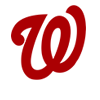

-1745819772711.png)
